Displaying items by tag: Simon Coveney
Cork Sailor and Former Marine Minister Simon Coveney Announces Surprise Step Down From Cabinet
Former Marine Minister Simon Coveney announced his surprise step down from Cabinet on Tuesday (2 April).
The Fine Gael TD for Cork South Central said his tenure in Cabinet “has been an amazing experience for 13 years” but that “the time was right” to step away as new party leader Simon Harris plans for an expected reshuffle, as RTÉ News reports.
Most recently Minister for Enterprise, Trade and Employment, Coveney served as Tánaiste from November 2017 to June 2020 and following that as Minister for Defence while also holding the post of Minister for Foreign Affairs and Trade until 2022, and was previously Minister for Agriculture, Food and the Marine from 2011 to 2016.
Coveney promised to “continue to work as a proud TD for Cork South Central and will of course actively support the Government in the Dáil”.
That will be some comfort to his many supporters, particularly in the Cork Harbour sailing community where the Coveney name carries significant weight.
Simon’s TD father Hugh Coveney, who famously raced in the George Bushe-built Golden Apple, was a stalwart of the Cork scene for many years.
And Simon himself is an experienced sailor, having worked as an instructor at his club the Royal Cork Yacht Club in Crosshaven and been involved in many sailing regattas over the years.
In 1997/98 he led the Sail Chernobyl Project which involved sailing a boat 30,000 miles around the world and raising €650,000 for charity.
Last summer, Simon Coveney addressed a sold-out audience at his home club to talk the future of sailing and the blue economy.
Coveney To be Questioned on Government Climate Action Plan
Minister for Enterprise, Trade and Employment Simon Coveney will be quizzed on the Government’s Climate Action Plan 2023 at an Oireachtas committee on Wednesday (Feb 22)
The Joint Committee on Environment and Climate Action has invited Mr Coveney, a former marine and agriculture minister who would be familiar with the implications of these aspects of the plan, to come before it.
The plan outlines what it terms a “viable pathway” to achieve a 51% reduction in Ireland’s overall greenhouse gas emissions by 2030, and net-zero emissions no later than 2050.
While agriculture is one of the main focuses, the plan seeks to bring measures that will also affect fishing vessels and benefit the marine environment.
It aims to manage land to protect “climate, biodiversity and water”, Minister for Marine Charlie McConalogue said when the plan was published last December.
Cathaoirleach of the Oireachtas committee, Green Party TD Brian Leddin said: “The Climate Action and Low Carbon Development Act 2021 provides that ministers come before the committee to discuss their department’s role in implementing the measures and achieving the targets set out in the climate action plan”.
“Over the coming weeks, the committee plans a series of such meetings. This week we look forward to meeting with Minister Coveney to discuss the actions of the Department of Enterprise, Trade and Employment in relation to the 2023 Climate Action Plan, and related matters,” he said.
The Joint Committee on Environment and Climate Action have 14 Members, nine from the Dáil and five from the Seanad.
The meeting in Committee Room 4 at 5.30 pm today (February 22nd) can be viewed live on Oireachtas TV.
Committee proceedings can also be viewed on the Houses of the Oireachtas Smartphone App, available for Apple and Android devices.
Russian military exercises planned for next week will no longer take place within Ireland’s Exclusive Economic Zone, the Foreign Affairs Minister has confirmed.
In a tweet published this evening (Saturday 29 January), Simon Coveney — who is also Minister for Defence — said: “This week I wrote to my counterpart, the Minister of Defence of Russia, to request a reconsideration of naval exercises off the Irish coast. This evening I received a letter confirming the Russian exercises will be relocated outside of Ireland’s EEZ. I welcome this response.”
The planned manoeuvres, which will include live-fire exercised by Russia’s navy and air force, have been the subject of much controversy in recent days.
This week I wrote to my counterpart, the Minister of Defence of Russia, to request a reconsideration of naval exercises off the Irish coast. This evening I received a letter confirming the Russian exercises will be relocated outside of Ireland’s EEZ. I welcome this response.
— Simon Coveney (@simoncoveney) January 29, 2022
Originally proposed for an area some 240km southwest of Cork, in international waters but within Ireland’s EEZ, the plans sparked concerns among the Irish fishing fleet and conversationists alike over the potential impact on important fishing grounds and habitats for vulnerable marine wildlife.
A marine craft advisory over “serious safety risks” surrounding the planned military drills was published by the Department of Transport, before a “successful and positive meeting” between fishing industry representatives and the Russian ambassador on Thursday.
Minister for Foreign Affairs Simon Coveney has confirmed that a team has been working on Ireland’s bid for the America’s Cup since January of this year.
The world’s biggest and oldest sailing event is ranked third only to the Olympics and a Football World Cup in sporting value for a host country.
Global viewership for the race in New Zealand this year was 940 million.
The current holders of the America’s Cup, Team New Zealand, have been exploring alternative venues after reportedly turning down a bid from their home nation’s government worth NZ$99 million, or some €58.3 million.
Ireland is on a shortlist, with Cork harbour as venue, and a final decision will be made in mid-September, Coveney said.
Coveney confirmed that Belfast and Dublin had also been assessed initially, but Cork won out in terms of infrastructure and international links – and the fact the city is built on one of the world’s finest natural harbours.
Galway was not considered due to lack of sufficient infrastructure and international connectivity, he said.
“Galway did host two Volvo Ocean Races and a lot of New Zealand sailors regard it as one of the most successful sporting events of all time,” Coveney said.
“There were some financial issues after the second Volvo ocean race, but that is a separate issue,” he said.
 As an Irish port, Cork Harbour won out in terms of its infrastructure and international links says Minister Coveney Photo: Bob Bateman
As an Irish port, Cork Harbour won out in terms of its infrastructure and international links says Minister Coveney Photo: Bob Bateman
“We had New Zealanders asking us about Galway, but essentially it was down to infrastructure and international aviation links,” he said.
Global sports investment group Origin Sports, headed by Cork-based Stewart Hosford, recently led a fact-finding visit to Cork for Team New Zealand’s assessment team.
The former Cork dockyard, a 44-acre site in Cobh, could provide a race village, and owners Doyle Shipping Group have been very supportive, Coveney said.
 Team New Zealand is the holder of the America's Cup Photo: Studio Borlenghi
Team New Zealand is the holder of the America's Cup Photo: Studio Borlenghi
“We have made the case that we can replicate a home here in Cork harbour for Team New Zealand which has many similarities to Auckland,” he said.
Coveney declined to comment on a figure for hosting the event but said that Ernst and Young were liaising with the Department of Public Expenditure and Reform on a detailed cost-benefit analysis.
“How we fund it, whether it is through a combination of urban renewal and other funds, has to be worked out, but it won’t happen if we don’t show the economic benefit”, he said.
In 2017, New Zealand’s business ministry estimated the America's Cup would be worth between 355 million euros to 592 million euros to the economy between 2018 and 2021 and hosting the event would create between 4700 and 8300 jobs.
 The 2021 America's Cup was the most watched
The 2021 America's Cup was the most watched
However, New Zealand recorded heavy losses on hosting the event due to the Covid-19 pandemic.
Coveney has said that a successful bid to host the America’s Cup yacht race would establish Ireland as a “leader of the blue economy within the EU” and would also be a significant expression of the Government’s “Global Ireland” initiative”.
 Race Day 3 and spectator boats watch the action in Auckland Harbour during the 36th America's Cup in March 2021
Race Day 3 and spectator boats watch the action in Auckland Harbour during the 36th America's Cup in March 2021
 Auckland's Dockside Race Village with Rock The Dock with Rod Stewart in full swing in March
Auckland's Dockside Race Village with Rock The Dock with Rod Stewart in full swing in March
“Some 2.5 million people came to see it when it was last in Europe, and we have taken a lot of learning from the Valencia experience,” Coveney said.
He said a successful bid would “fast-track Project Ireland 2040 investment in Cork, in particular Cork harbour’s ambition in becoming Ireland’s offshore renewable energy hub by supporting €5bn capital deployment in wind projects, creating 10,000 jobs over the next decade.”
Dr Val Cummins of Simply Blue Energy said that hosting an event like the America’s Cup would focus attention on Ireland’s island potential and its blue economy.
Professor sailor Maurice “Prof” O’Connell said that Ireland was in a very strong position to win the bid if it moves from New Zealand, and the proposed race hub at Cobh would be “tailor-made” for 60 to 70 superyachts.
“This is not just a weekend of sport, but a two year plus boost, with six or eight sailing teams basing themselves in the host country from 2022, along with designers, engineers, sports scientists, managers and so on,” O’Connell said.
Port of Galway harbourmaster Capt Brian Sheridan – who first proposed publicly that Ireland should consider holding the America’s Cup - said that Galway had much expertise to offer, having hosted two Volvo ocean races.
“These new foiling boats we have seen in America’s Cup races don’t have keels, so don’t require depth of water – and Galway Bay is a natural amphitheatre for spectators,” Sheridan said.
Over 100 boats are expected to enjoy four days racing in the open waters of Kinsale Harbour when the Sovereign’s Cup 2017 takes place at Kinsale Yacht Club from 21st-24th June, 2017.
The O’Leary Life & Pensions sponsored event was launched at Kinsale Yacht Club today by Simon Coveney TD, Minister for Housing, Planning and Local Government.
Minister Coveney praised the co-operation between all the stakeholders and cited Sovereign’s Cup as a prime example of what can be achieved to bring benefits to whole communities when clubs and associations work closely with business groups and local authorities to organise world class events.
 Jack Roy at his first official event as President of the ISA, Carrie Dunne, Ronan Goggin, O’Leary Life & Pensions, Minister Simon Coveney, Susan Horgan, Rear Commodore KYC, Cllr Kevin Murphy, Cork Co Council, Dave O’Sullivan, Vice Commodore KYC.
Jack Roy at his first official event as President of the ISA, Carrie Dunne, Ronan Goggin, O’Leary Life & Pensions, Minister Simon Coveney, Susan Horgan, Rear Commodore KYC, Cllr Kevin Murphy, Cork Co Council, Dave O’Sullivan, Vice Commodore KYC.
Some of the entries to the Sovereign’s Cup 2017 to date include 2015 Champions, Equinox the X-333 from Howth YC, skippered by Ross McDonald.
Also returning to Kinsale are WOW, the Farr 42 sailed by George Sisk, DUX, the X302 sailed by Anthony Gore-Grimes, Fool’s Gold the Archambault 35 sailed by Robert McConnell and Jump Juice, the Ker 37 sailed by Conor Phelan.
The J-109s are represented by Jump The Gun, sailed by John Kelly and Michael Monaghan, White Mischief, sailed by Tim & Richard Goodbody, Powder Monkey, sailed by Mark Byrne and Chris Moore and Indecision sailed by Declan Hayes.
 J109, Jump The Gun, sailed by John Kelly and Michael Monaghan is heading for Kinsale
J109, Jump The Gun, sailed by John Kelly and Michael Monaghan is heading for Kinsale
Half Tonners, Checkmate XVIII, sailed by Nigel Biggs, The Big Picture, sailed by Michael Evans and Checkmake XV sailed by David Cullen will enjoy great racing in advance of the Half Ton Classic Cup that also takes place in KYC from 14th-18th August.
There are a number of 1720 sportsboats including Antix, sailed by Anthony O’Leary, Dutch Gold, sailed by Peter O’Leary, T-Bone, sailed by Clive O’Shea and Tom Durcan, Déjà vu, sailed by Rory and Ross Johnson, Aquatack, by Denis Murphy and 1601 sailed by Michael Walsh.
Kinsale YC is well represented by Meridien, skippered by KYC Commodore, Tom Roche, Freya, sailed by Conor Doyle, Artful Dodger sailed by Finbarr O’Regan and Cimarron VI, sailed by Vice Commodore Dave O’Sullivan.
Ireland & Cork Sailing On A High As Vendee Globe Hits World Target
Enda O’Coineen may have exited the Vendee Globe in dramatic fashion on New Year’s Day when, as he drolly put it, Kilcullen Voyager stopped stone dead as she zapped into the back of a Southern Ocean wave, but his enormous mast just continued straight on with an almighty crash as it broke off clean at the deck. But this ruthless race continues on its way, and there’s still much of very specific Irish interest in it as the leaders approach the finish. W M Nixon gives us his own take on it all, and then tells us a tale out of school about Irish involvement.
It has to be the oddest geography lesson ever provided. And it has to be the most unexpectedly energetic way of promoting a relatively unknown region of France which was formerly almost exclusively associated with a relaxed way of life.
Once upon a time, the Vendee was a place which you’d usually associate with the gentler things in life. Things like good food and summer wine enjoyed in a sleepy siesta lifestyle in gently dusty villages inland from some fine beaches, villages where life moves slowly under the kindly shade of many trees, in a latitude which is not so far south as to be overly hot in summer, yet not far enough north to experience harsh winters.
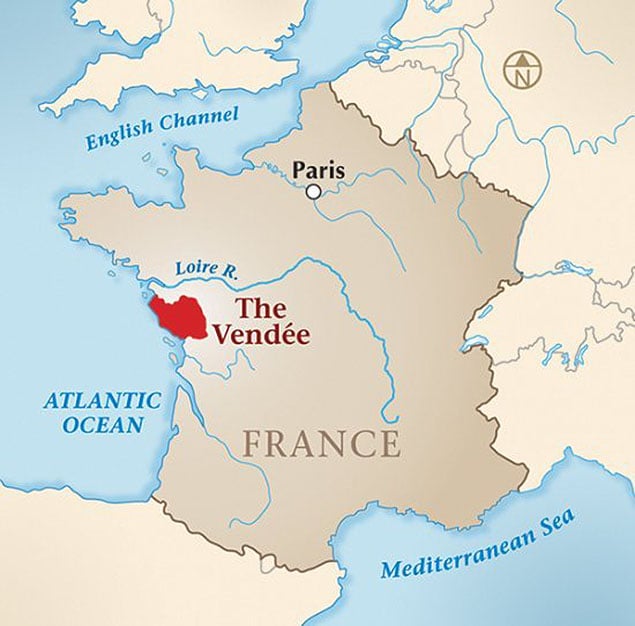 Little place that thinks big – France’s Vendee region has put itself firmly on the world map by sponsoring the Vendee Globe
Little place that thinks big – France’s Vendee region has put itself firmly on the world map by sponsoring the Vendee Globe
It’s about the size of an average Irish county. Yet right now, France’s modestly endowed Vendee region is being promoted as a place of world significance by extreme sportsmen taking part in a rugged sailing exercise with the most severe physical and life-threatening challenges, subsisting on a meagre diet which would rightly produce rioting in any self-respecting prison.
Welcome to the world of the Vendee Globe. That is, in the unlikely event that you aren’t already addicted to following it on a daily or indeed hourly basis. This still almost unbelievable round the world non-stop marathon continues to have an air of crazy novelty and enduring fascination, even though it was first staged in 1989.
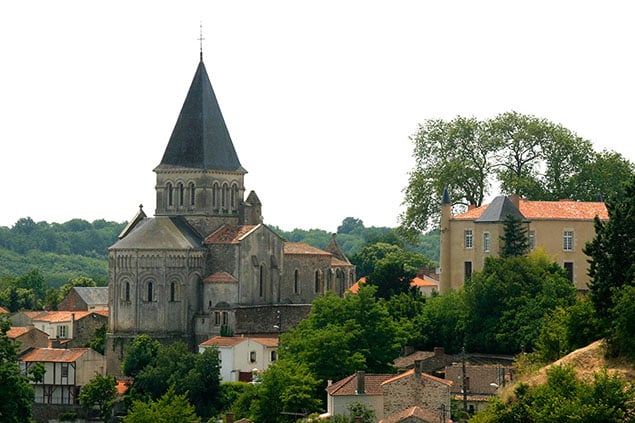 Peaceful countryside. Deep in the heart of the Vendee, the sea seems far away
Peaceful countryside. Deep in the heart of the Vendee, the sea seems far away
It boggles the mind to try and imagine the great French sailor Philippe Jeantot taking on the challenge of persuading the civil servants and politicians who run this relatively remote region of west France to permit, let alone sponsor, an event which is now utterly out on its own. Yet the regions of France quite rightly have an intense local pride. And if we in Ireland feel a tinge of envy at what they can achieve, just remember that last weekend it was announced that Wicklow Sailing Club had become the Mitsubishi Motors Club of the Year for 2017 thanks to their utter commitment to promoting the Round Ireland Race on a biennial basis, while at the same time continuing to function successfully as a club which caters for local sailing needs.
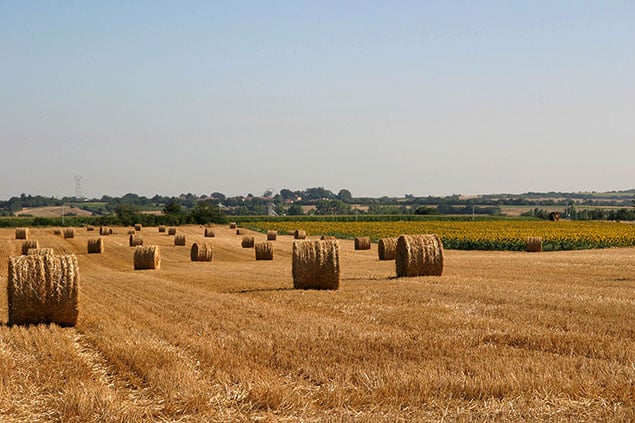 A summer cornfield in the Vendee is about as different as you can get…
A summer cornfield in the Vendee is about as different as you can get…
 ….from rounding Cape Horn in a rising gale. Yet both are linked through the world’s most challenging race
….from rounding Cape Horn in a rising gale. Yet both are linked through the world’s most challenging race
It’s something which is unusual in an overly-centralized country like Ireland, where all major decision are made in the capital, and in sailing you’d expect one of the main centres such as Cork Harbour or Dublin Bay or Belfast Lough to be the home of the Round Ireland race. But it is dogged little Wicklow which has won through, and 2016’s race fully justified their faith.
However, in the Irish context it is a local sailing club which is setting the pace. But in France, it is the regional administration which has been persuaded to pull off a remarkable coup. Looking at the scale and publicity which accompanies the Globe race, you’d assume it starts and finishes in a major centre such as Brest, or Lorient, or La Rochelle. Au contraire. The Vendee Globe starts and finishes in the very artificial sand-surrounded port of les Sables d’Olonne, set on a long sandy coast off which just about the only object of interest is the intriguing little Biscay island of Ile d’Yeu.
 Les Sables d’Olonne, where the harbour is tucked in behind what used to be sand dunes
Les Sables d’Olonne, where the harbour is tucked in behind what used to be sand dunes
 The start of the Vendee Globe 2016-2017
The start of the Vendee Globe 2016-2017
Yet despite the paucity of features of special interest along its sandy beaches, every three to four years sees Les Sables d’Olonne being swamped by hundreds of thousands of visitors when the Vendee Globe circus is in town. And this weekend, the focus sees the Race Headquarters move from their race-time base at the foot of the Eiffel Tower in Paris back to the quayside at Les Sables in anticipation of the finish, some time in the middle of next week, of the two fleet leaders.
Yesterday, gales on the Biscay coast prevented the re-installation of the super-tented Vendee Globe Village in Les Sables. But by today the command control should be broadcasting again on all media, and we can resume our daily doses of a fascinating event which is reaching its most crucial stage in an unexpected way.
For after a week in which severe storms have been sweeping most of Europe, a great big high pressure area is showing every sign of settling in over the southwest approaches to the Bay of Biscay right across the track which the two leaders – Armel le Cleac’h on Bank Populaire VIII and Alex Thompson closing up from 130 miles astern on Hugo Boss – will have to take to get to Les Sables.
C’est ridicule! The seas off northwest Spain - Galicia, Finisterre, whatever you want to call it – should be one of the stormiest places in the world in the latter half of January. Yet here it is, in an increasingly benign mood, with the final stages of the world’s breeziest race threatening to become a battle of the zephyrs.
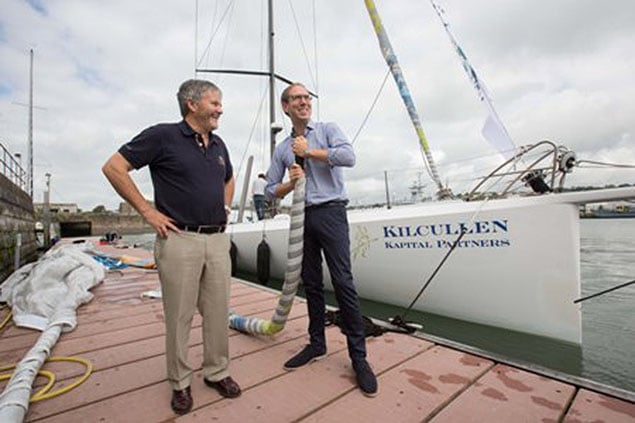 Enda O'Coineen and Stewart Hosford in Cork Harbour in 2015
Enda O'Coineen and Stewart Hosford in Cork Harbour in 2015
Under time-honoured traditional yacht racing tactics, all Le Cleac’h need to do is keep re-positioning himself so that he is directly between Thomson and the finish line. But these are not traditional yachts. Even in a zephyr, they can virtually create their own wind, and if the leader really does become so completely and utterly becalmed that he loses steerage way, the second-placed boat knows that his primary objective must be to maintain way even if it means actually heading away from the finish.
However, let’s face it, it is January, and it’s unlikely the total calm you might experience in high summer will ever settle in. That said, for le Cleac’h the situation is hugely challenging, for if there is one other skipper in the entire race who has the ability to pull off an audacious coup and snatch the lead, then it is 42-year-old Alex Thomson.
And in a sense, here in Ireland we can look on him as one of us. For five formative years of his childhood, he lived in the Crosshaven area, and his name can be found in the register of Templebreedy National School. His father Peter was a helicopter pilot on air-sea rescue duty, which meant that Alex was born in Bangor in North Wales as his father at the time was flying out of Anglesey, but then the move came to Cork airport, and the young Alex saw his first sailing off Weavers Point.
Sailing the seas of Cork at that time was young Stewart Hosford whose father Bill was one of the crew on Denis Doyle’s blue S&S designed Moonduster. Bill Hosford was also one of the consortium involved with Barry Burke in building the Ron Holland-desined Shamrrock racer-cruiser range, while for some added interest Bill and his wife Ann for ten years owned that deservedly renowned West Cork hostelry Mary Ann’s in the picturesque village of Castletownshend.
However, the challenge of life as an international banking executive drew young Stewart away from Cork, and he spent fifteen years in the City of London and another five in Edinburgh before the call of the sea returned, and he and his mates bought the Farr 65 Spirit of Diana in 2000 and linked up with the recent winning skipper in the Clipper Round the World Race, one Alex Thomson, to go racing. The rest is history.
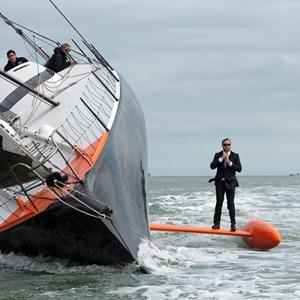 “Alex does the sailing and the stunts…..” A spot of keel-walking with Hugo Boss
“Alex does the sailing and the stunts…..” A spot of keel-walking with Hugo Boss
 Even when things don’t go quite according to plan, somehow it still seems a success…
Even when things don’t go quite according to plan, somehow it still seems a success…
The synergy between the two men in creating a boat racing organization is extraordinary. Even though Stewart is now based back in Cork, life is totally peripatetic as he fulfills the role of CEO of Alex Thomson Racing, while Alex does the sailing and the stunts, and Sir Keith Mills is the third corner of a remarkable triangle for creating success.
The well-established link-up with Hugo Boss completed the package, and while on occasion things have gone spectacularly wrong, there’s something about an Alex Thomson Racing failure which makes it into a success. The man himself has a superhuman dedication and determination, and an ability to think completely outside the box, which makes their involvement in any event add greatly to its success.
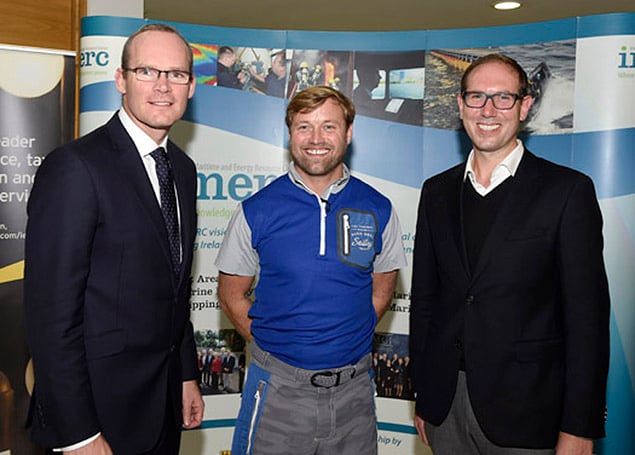 The then Minister for the Marine Simon Coveney with Alex Thomson and Stewart Hosford at a press briefing to put forward some proposals for developments on Cork Harbour
The then Minister for the Marine Simon Coveney with Alex Thomson and Stewart Hosford at a press briefing to put forward some proposals for developments on Cork Harbour
Most of us have lost count of how many different boats called Hugo Boss there have actually been, but there’s no doubt the current boat – after some setbacks which would have rebuffed a lesser squad – has evolved into on of the most formidable racing machines on the planet.
So even though it’s unlikely she’ll get starboard tack all the rest of the way to the finish in order for her lack of a starboard foil not to be a disadvantage, Hugo Boss racing has now reached such a level of attention that any outcome is ultra-newsworthy.
But though we talk of the Alex Thomson Racing challenges having reached a certain kevel, staying level is that last thing on the minds of these guys. They’ve all sorts of other ideas taking shape, and their track record is such that if they were so inclined, they could make a tidy living as consultants to nascent challenge projects. That is most unlikely. They’ve moved on a long way from Templebreedy. But even so, it still means a lot to Alex Thomson and Stewart Hosford when the latest Hugo Boss puts in an appearance at Crosshaven.
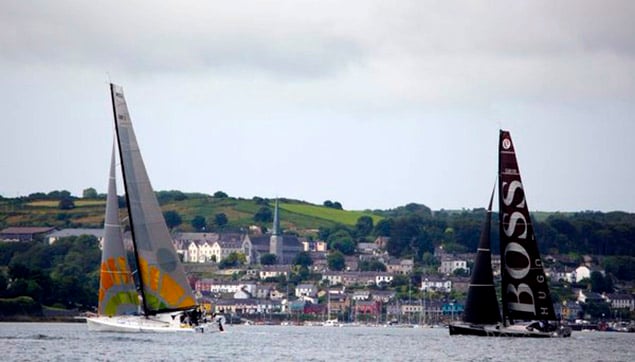 Enda O’Coineen’s Kilcullen Voyager and the previous Hugo Boss off Crosshaven, where Alex Thomson spent five years of his childhood.
Enda O’Coineen’s Kilcullen Voyager and the previous Hugo Boss off Crosshaven, where Alex Thomson spent five years of his childhood.
High Hopes for Ireland's Tall Ship – The Force is With Them
The governments in both jurisdictions in Ireland have included an all-Ireland sail training ship for the Atlantic Youth Trust in their long term capital expenditure proposals. And the movement in favour of support for this project has become so strong that the nationwide team involved in promoting it are confident that the ship’s future is now secured.
They continue to hold this view even with general elections and possible major changes in administrative direction taking place, north and south, within the next four months. Thus this week’s 2016 Annual General Meeting of the Atlantic Youth Trust in Irish Lights Headquarters in Dun Laoghaire found itself reviewing a remarkable year of progress and achievement, while giving pointers and reassurances for the successful way ahead. W M Nixon was there to take on board an evening of multiple messages.
It could well be that some time in the future, we will come to the sad but inescapable conclusion that the foundering of the Republic of Ireland’s national 84–ft sail training brigantine Asgard II in September 1908, followed within two years by the sinking of the Northern Ireland 70ft training ketch Lord Rank, were necessary disasters for the progress towards the ultimately more healthy ideal of a Class A 40-metre sail training barquentine.
The proposed ship - determinedly and enthusiastically serving all Ireland – will be initially funded through donations, and by government grants from both sides of the border. But the vessel is to be run independently by a cross-border trust rather than by some obscure unit of a government department.
September 2008 saw Ireland on the edge of the financial abyss. For a government under enormous pressure from all sides, a government, moreover, in which the minister responsible for the Asgard II took little or no interest in the ship and what she did, this sinking was a blessing in disguise.
The hull of Asgard II, completed in 1981, had long passed its sell-by date. When she sank, she took with her the magnificent rig which had been totally replaced only a couple of years earlier. Yet a properly involved government would surely have taken on board the advice that her timber hull urgently needed replacing, preferably with one built in steel. For although in 2008 the ship looked better than ever thanks to the devotion of her crew in working way over and above the call of duty in painting, varnishing and routine maintenance, there was no escaping the fact that the basic hull and its original fittings were living on borrowed time.
Ironically, the visit to La Rochelle, which she was nearing when she sank, included plans for a three-week stopover for a complete survey and some necessary repairs. Whether or not this would have revealed the fracturing seacock which many reckon to have caused the unstoppable ingress of water can only be a matter of speculation. The fact of the matter is the ship sank, and in an exemplary display of seamanship, the captain and crew ensured that their full quota of young trainees got safely away.
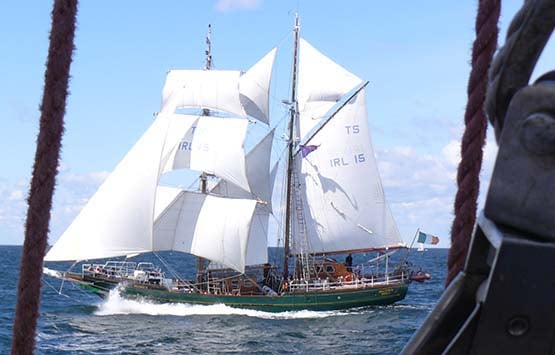
Flying the flag for Ireland – Asgard II in fine form, seen from another tall ship
But although Asgard II remained stubbornly intact and upright for some weeks on the Bay of Biscay seabed off Belle Ile, a government with financial Armageddon crashing down around its ears was glad enough to be shot of a unique project which some of them had never really understood or supported in the first place. Thus they refused to consider multiple suggests as to how best Asgard II could be salvaged. And frankly, it was for the best that they did so. For like it or not, while she was much-loved by the maritime community, the vessel had lost public confidence.
The subsequent loss of the Lord Rank in July 2010 after striking a rock likewise resulted in a merciful absence of casualties. But with Ireland north and south now in the utter depths of economic recession with no governmental enthusiasm whatsoever for non-essential projects, it was time to re-group for a few years and re-think the entire sail training ideal. It became almost an underground movement, with Coiste an Asgard being re-structured as Sail Training Ireland, and diligently setting about placing Irish trainees on the ships of other nations. It’s an ongoing programme which has been notably successful in providing both sea-going experience and a guaranteed international dimension for young people from all over Ireland, city and country alike.
Meanwhile there were rumblings from the west of Ireland where Enda O'Coineen and John Killeen were building on the can-do attitude of Galway, and from this there gradually emerged the Atlantic Youth Trust. It’s a determinedly all-Ireland group in which the Chairman is former Winter Olympics Gold Medallist Lord Glentoran from Northern Ireland, with the unstoppable unsinkable O Coineen as President. Supporting them is one very impressive list of seriously heavy hitters in the maritime and big business sphere from all over Ireland on its board, and perhaps most importantly of all, at an early stage they secured Neil O’Hagan as Executive Director.
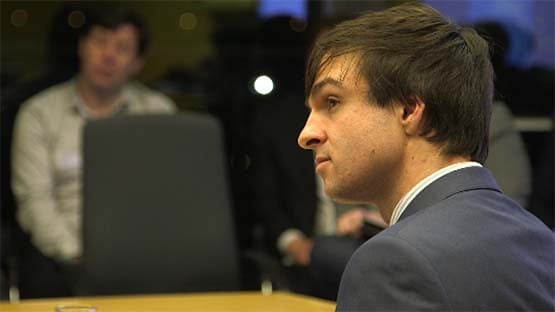
Neil O’Hagan, Executive Director of the Atlantic Youth Trust
This sounds an impressive title, but at the moment he heads up a minimal staff. You can get the flavour of it all by taking a look at the Sailing on Saturdays conversation I had with him, reported here on 4th April 2015. The amount of work he puts in is prodigious, and though the Trust’s founding General Meeting was held in Belfast in the Harbour Commission’s historic building on September 10th 2014, they’d to forego a General Meeting during 2015 while various elements and agreements were being finally edged into place.
Since April 2015 we’ve had snippets of news about the governments north and south starting to provide what are essentially government letters of intent in support of the project. However, politics on this island being a snakelike progression notwithstanding the best efforts of St Patrick, with every twist and turn of the political machines the AYT have been at pains to ensure that gains supposedly agreed by one administrative decision-maker are carried through into the remit of the next when the inevitable political wheel of fortune turns yet again at the individual level.
But now, with two general elections in the offing and a rapidly improving situation developing in the AYT’s prospects, it was essential for a properly-convened AGM to be held on Thursday January 21st, staged this time in the impressive board-room of the Irish Lights Commissioners in Dun Laoghaire.
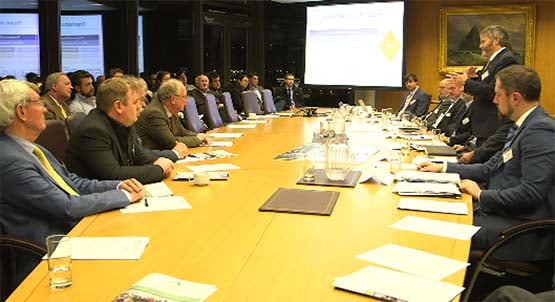
The boardroom at Irish Lights HQ is an impressive venue for any meeting, and it suited the Atlantic Youth Trust’s 2016 AGM very well
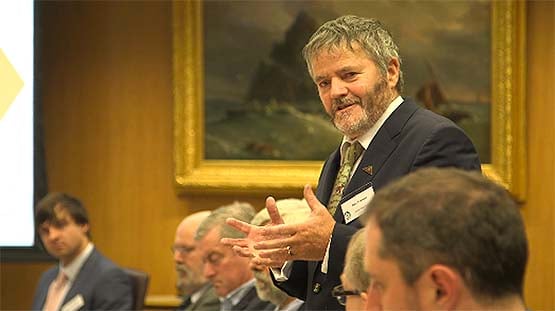 The maritime evangelist……Enda O'Coineen in full flight at this weeks AGM of the Atlantc Youth Trust
The maritime evangelist……Enda O'Coineen in full flight at this weeks AGM of the Atlantc Youth Trust
Ironically, although one of the main lines of thought in the AYT’s thinking is that the ship they’ll provide will be more of a floating multi-discipline schoolship of many projects, both afloat and ashore, rather than a traditional sail training ship, it emerged at the AGM that it was the traditional Tall Ships visit and Parade of Sail in Belfast and on Belfast Lough last July which gave them their greatest boost.
They’d a significant presence there, and thanks to one of the Trust Board Members, they’d the use of a fine big motor vessel aboard which visiting politicos and other heavy hitters could be taken on a sociable yet instructive tour of the harbour and the Tall Ships fleet. For many of these decision makers and opinion formers, it was a transformative experience, turning them into supporters of the Atlantic Youth Trust’s way of thinking.
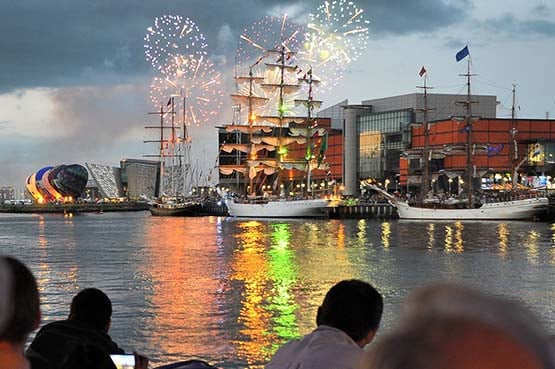
The Tall Ships in Belfast, July 2015
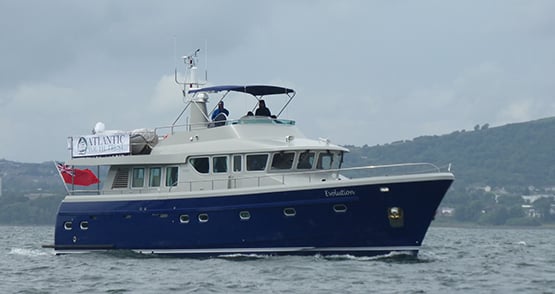
This opened doors north and south, and they rapidly increased their already formidable knowledge of how to work the corridors of power. The meeting on Thursday in Irish Lights was chaired by Peter Cooke from the north, and his affable presence made the running of business very smooth indeed. But as each specialist on the board revealed the progress they’d made during the past year and more in their particular task, it was to realize that here were people who were utterly professional in their approach, yet went at the job with the total enthusiasm of dedicated amateurs.
But what most impressed was the synergy of the high octane talents on the board which, in addition to Lord Glentoran, Enda O Coineen and Peter Cooke, can draw on the talents of people of the calibre of Dr Gerard O’Hare, Roger Courtney, Sean Lemass, David Beattie and John Killeen – with Neil O’Hagan as the key conduit, they’ve turned themselves into a formidable lobbying organisation.
It’s a fact of life in all Irish political administration, and particularly in Dublin, that each separate government department much prefers to function independently within its own little bubble, with nothing whatever to do with any other department while avoiding overlaps if at all possible. This is especially so in the neglected area of maritime activity, which is overseen by several departments, and is further warped by the reality that the government is in Dublin - which is also the biggest port - yet the real scene of the maritime action and the true hotbed of ideas is Cork.
So our shrewd operators in the AYT stood back and concluded that the politician they should most directly target was of course Minister for the Marine (and many other matters) Simon Coveney TD of Cork, but that in Dublin the departments to be wooed were Finance and the Office of the Taoiseach.
With increasing support at official level in the north and enthusiasm from key decision makers in the Republic, things were going grand when the President of the AYT suddenly went off in December 2015 to race single-handed across the Atlantic from the Caribbean to Brittany in his IMOCA 60 Kilcullen Voyager. Enda O’Coineen’s big boat has been very much part of the AYT awareness programme for the past year, taking trainee crews to sea. But this was something else altogether, and it made many supporters of the new training ship ideal distinctly nervous.
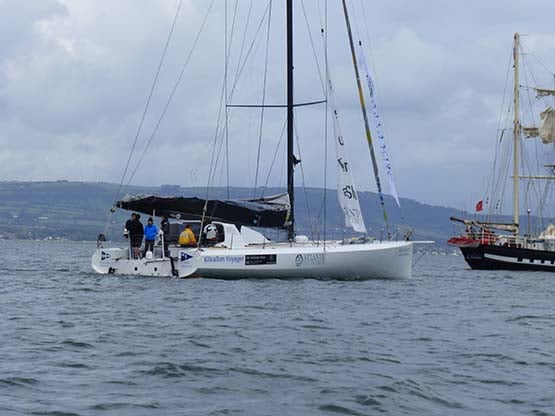
Racing across the Atlantic in as rough a December as anyone could remember may have been a personal challenge, but inevitably it was a high risk venture with which the AYT was inevitably associated, whether it liked it or not. The sailing community in Ireland is small, and nothing can happen in isolation. But to everyone’s enormous relief, not only did the boy do it, but he did it well, sailing across in style and securing a podium place with third at the finish.
This was quietly acknowledged as something which had been on everyone’s mind in a graceful little speech by the Deputy Chairman of the Irish Lights Commissioners congratulating the President on his Transatlantic success. So with everything in place as regards where AYT now stands in relation to both governments, the formal part of the meeting concluded with some commitments as to the way ahead, and the news that the Atlantic Youth Trust’s next public gathering of significance will be in Galway on March 12th, when more precise details of the new ship and the building programme will be revealed.
However, with an ethos in which going the extra mile is part of the DNA, the AYT then laid on a hugely entertaining dinner in the neighbouring Royal Irish YC with fascinating shows by the Gardai Siochana’s Conor O’Byrne, who played a central on-board co-ordination role in rescuing a crewman who had gone overboard in mid-Pacific from the Clipper yacht Derry-Londonderry-Doire, and from Stewart Hosford from Cork, who is CEO of the organisation Five Degrees West whose main project is the designing, building and management of the Imoca 60 boats raced under the Hugo Boss campaign by Alex Thompson.
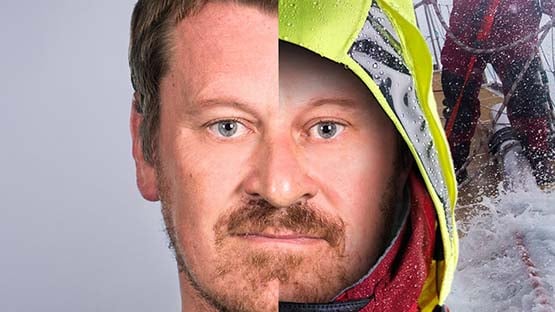 May The Force Be With You – the two faces of the Garda Siochana’s Conor O’Byrne, who gave the AYT and its supporters a fascinating insight into the successful rescue of a crewmember who went overboard from Derry/Londonderry/Doire in mid-Pacific.
May The Force Be With You – the two faces of the Garda Siochana’s Conor O’Byrne, who gave the AYT and its supporters a fascinating insight into the successful rescue of a crewmember who went overboard from Derry/Londonderry/Doire in mid-Pacific.
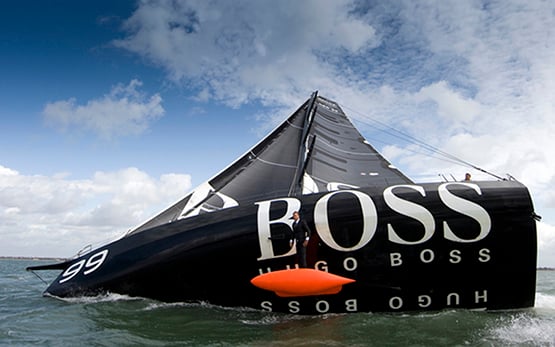 Suits you, Sir…..Alex Thompson on the second Hugo Boss. At Thursday’s meeting, Stewart Hosford of Cork – whose interest in the sea and sailing was inspired by Asgard II – gave the inside story on his job as CEO of the Hugo Boss sailing challenges.
Suits you, Sir…..Alex Thompson on the second Hugo Boss. At Thursday’s meeting, Stewart Hosford of Cork – whose interest in the sea and sailing was inspired by Asgard II – gave the inside story on his job as CEO of the Hugo Boss sailing challenges.
Each compact yet thought-provoking show would have made for a worthy topic on its own in most clubs’ entertainment programme. But it was special to include both on this night of all nights, as each speaker had been enthused in their youth by sailing on Asgard II, and each would do anything to ensure that the upcoming generations get a similar opportunity and inspiration.
It was that kind of night, with the congenial attendance including Seamus McLoughlin and Michael Byrne from Sail Training Ireland, and Oliver Hart whose 70ft schooner Spirit of Oysterhaven continues gallantly to fulfill the role of Ireland’s premier sail training vessel from her base on the Cork coast.
In all, it’s a busy few days for Irish sail training, which is definitely no longer an underground movement. Today, Sail Training Ireland hold their 4th Annual Prize Giving and Programme Launch in the Mansion House in Dublin, looking back on a season in which the number of funded trainees sent on sailing ships abroad and at home came in at just under 300, while in all they arranged berths for more than 500.
The plan for 2016 includes a formal twinning of Dublin and Liverpool for maritime festivals, while on the training front, STI are aiming for a target of 350 funded trainees. And as for Ireland eventually returning to having her own sail training ship, no sooner was Thursday night’s remarkable series of events brought to a close than Neil O’Hagan had to gather his thoughts and head off for New York to meet the Ireland Fund. They are taking a serious and very positive interest in the plans of the Atlantic Youth Trust.

€18m in Fishery Harbour Works Announced
Pontoons in Cape Clear, West Cork a small craft harbour in Killybegs, County Donegal and dredging works in Howth, County Dublin are part of an €18m Capital Investment Package in 2016 for the development of Ireland’s fishery harbour network announced today by Minister for Agriculture, Food and the Marine, Simon Coveney T.D. See the full table below.
Announcing the investment package, the Minister said “In total I am allocating €18m for this year's Fishery Harbour and Coastal Infrastructure Capital Programme. I have set aside €16m towards safety, maintenance and new development works at the six Fishery Harbour Centres at Howth, Dunmore East, Castletownbere, Dingle, Rossaveel and Killybegs. I am also making €2m available for a Local Authority Harbour Programme, and I am assessing specifically what is required to address storm damage at Local Authority owned fishery harbours.”
Flagship projects in the 2016 Capital Programme (see table1) include the provision of dedicated Ferry pontoons on the West Pier in Howth, infrastructure upgrades in Dunmore East, commencement of the Dinish Wharf expansion Project in Castletownbere, expansion of the small craft harbour in Ros an Mhíl and the Smooth Point pier extension in Killybegs. The Minister continued, “While there are a number of flagship projects for completion this year, of equal importance is the preparatory work for significant potential projects in Howth, Dunmore East, An Daingean and Ros an Mhíl”
The 2016 Fishery Harbour and Coastal Infrastructure Capital Programme outlined by the Minister also contains funding of €2m to assist coastal Local Authorities repair, maintain and develop piers, harbours and slipways under their ownership. The Minister stated “I am delighted to continue to support Local Authorities in their efforts to maintain and develop the fishery harbour network which provides much needed facilities for our rural fishing and marine focussed communities. A number of smaller fishing piers around the coast experienced some damage during the recent storms and we are currently assessing how best to assist Local Authorities in carrying out repairs”
Concluding on the 2016 Fishery Harbour and Coastal Infrastructure Capital Programme, the Minister said “This year’s programme is significant on a number of fronts, firstly it provides for the continuation of this Governments strategy to develop and improve the facilities at our fishery harbours in 2016. Secondly it prepares the groundwork for potential projects in the coming years all of which will benefit the fishing industry, seafood processing sector, other ancillary marine industries.”
Table 1- Fishery Harbour & Coastal Infrastructure Development Programme 2016
| Location | Project | Cost €m |
|
Howth: |
- Traffic Management Works - East Pier Repairs - Pontoons to west pier for ferry landings - Engineers office - Preparation of Dumping at Sea licence - Provision of Berthing Face to Middle Pier - Electric Works West Pier - Gas Main - Other Services (Sewers,ducting,watermains) Total |
0.150 0.050 0.400 0.050 0.100 0.100 0.300 0.150 0.150 1.450 |
|
Dunmore East: |
- Harbour Office Upgrade - West Wharf upgrade - Breakwater (Design Report) - Harbour Road re-surface Total |
0.700 0.200 0.160 0.100 1.160 |
| Castletownbere: |
- Harbour User toilet and Shower facilities - Dinish Wharf Expansion - Harbour Slipway - Quayside Electrical Upgrade - Harbour Offices Upgrade - Replacement of water network Dinish - Dinish Bridge Survey - CCTV Total |
0.090 1.000 0.040 0.150 0.250 0. 450 0.080 0.070 2.130 |
|
An Daingean:
|
- Workshop Design ,Planning and commence works - Capital Dredging Navigation Channel – Dumping at sea Licence, tender preparation and preparation works - Net mending area Total |
0.400 0.500 0.100 1.000 |
|
Ros an Mhíl:
|
- Quay Development – Design, Evaluations, Consulting, EIS, Permitting and preparation works - Small craft Harbour – Dredging Total |
0.800 1.800 2.600 |
|
Killybegs:
|
- Repairs to Blackrock/Auction Hall Piers - Small Craft Harbour - Smooth Point Pier Development - Landing Pier Fendering - Landing Pier Electrical Design/Works - Boatyard investment Total |
0.175 0.900 2.500 0.300 0.190 0.0 70 4.135 |
|
Cape Clear
|
-Pontoons Total |
400 0.400 |
| Total Departmental Owned Marine Infrastructure projects | €12.875 | |
| Safety and Maintenance and Non-Discretionary and Contractual Capital Commitments 2016 (incl Disability Access) | €3.120 | |
| Total Local Authority Harbour Development and Marine Leisure | €2.000 | |
| Total Fishery Harbour and Coastal Infrastructure Capital Programme |
€17.995
|
|
The Minister for Agriculture, Food and the Marine, Simon Coveney TD, today expressed concern at proposals for some of Ireland’s key fisheries quotas, ahead of annual EU Fisheries negotiations in Brussels next week. The Minister said that the rolling out of the new discards ban for a number of Irish stocks added to the complexities of this year’s negotiations.
Minister Coveney said today that “Some of the proposals for stocks of great importance to Irish fleets are unnecessarily restrictive in my view and do not reflect scientific advice. We must set quotas that support sustainable fish stocks and I will support cuts where the scientific advice is clear that that is the right thing to do. The Commission is proposing a 43% and 27% cut to our cod and haddock quotas in the Celtic Sea, these stocks are stable and cuts of this magnitude are not justified. Other serious cuts are proposed for our very valuable prawn quota which is not supported by the scientific advice and for whitefish quotas in the Irish Sea. We must set quotas that support sustainable fish stocks and I will support cuts where the scientific advice is clear that that is the right thing to do. I will be making a strong case next week to Commissioner Vella to make significant changes to these quota proposals. ”.
The Minister added that “There is an added complexity to this year’s negotiations as the new landing obligation for certain stocks will apply from the 1st of January 2016. During the reform of the Common Fisheries Policy, brokered by Ireland, I was a strong advocate of a phased introduction of discards ban to end the wasteful practice of discarding high volumes of fish at sea. As part of that Reform, it was also agreed that quotas would be adjusted upwards for stocks covered by discards ban to take account of the new situation that all catches must now be landed. It is vital that this ‘uplift’ in quotas is fully applied to the stocks that come under the discards ban in 2016, to support its practical implementation.”
In 2016 Irish fisheries covered by discards ban include prawns, whiting in the Celtic Sea and Haddock in the Irish Sea and the area west of Scotland.
Minister Coveney concluded by saying that “I am meeting our industry representatives this evening in advance of Council and I also intend to meet other stakeholders on margin of the Council to get a full understanding of priorities. During the Council I will keep the industry representatives and other stakeholders fully up to date on progress and developing issues.”
The Annual Fisheries negotiations to decide on quotas for 2016 takes place on the 14th and 15th of December in Brussels.
Issues Of Importance For Irish Fishermen Highlighted In Advance Of The December Fisheries Council
The Minister for Agriculture Food and the Marine, Simon Coveney met Karmenu Vella, European Commissioner for Maritime Affairs and Fisheries during a visit to Malta today (Monday 9th November). The meeting covered the setting of fishing quotas for 2016, the introduction of the first phase of the discards ban for the whitefish fleet in 2016.
The Minister said “During my visit to Malta to meet the officers and crew of the LE Samuel Beckett, I held an informal and constructive meeting with Commissioner Vella. I set out some of the challenges facing our fishing industry in 2016, particularly for the whitefish and prawn fleets with introduction of the discards ban for some fisheries. The discards ban will directly apply next year to our important prawn fleet and our Celtic Sea whiting fleet. I made clear that I will be working at the December Council to achieve quotas that take account of this new situation where all catches in these fisheries must be landed. While I fully support the introduction of quotas that respect scientific advice, I pointed out that in line with the new Common Fisheries Policy, I will be looking for a phasing in of the new limits recommended by the scientific advice for some key economic stocks, which will be fished by the fleets which are becoming subject to the discards ban.”
Minister Coveney took the opportunity to brief Commissioner Vella on the issues highlighted by a recent report in the Guardian newspaper on illegal migrant workers on Irish fishing vessels. The Minister advised that the Irish Government has established a Task Force to examine the issues fully and to make recommendations on appropriate actions as a priority before the end of the year. Minister Coveney undertook to advise the Commissioner on the work of the Task Force and the Irish Government’s planned response.
The meeting also focused on the ongoing mackerel sharing arrangements involving the EU, Norway, Faroe Islands and the possible inclusion of Iceland and Russia under a new agreement. The mackerel fishery is economically the most important to Ireland and there are ongoing discussions under a Coastal States process to reach a long term agreement on the management of the stock.
Concluding the Minister said “Commissioner Vella undertook to work closely with us over the coming weeks in order to secure a balanced range of quotas for the Irish fleet”.































































